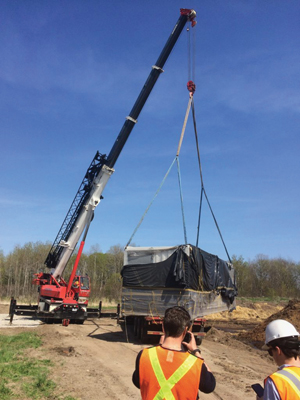By Stephen Kishewitsch
 The one that started it all: Windshare’s 750 kW Lagerway turbine, overlooking the Queen Elizabeth expressway on Toronto’s lakeshore. Photo: Paul Gipe
It began with a single wind turbine, paid for and owned by ordinary citizens, a thousand dollars or so at a time, in partnership with the local power utility. That initiative has evolved into a family of independent organizations, including a nation-wide renewable energy education charity and North America’s largest solar energy co-operative. The TREC Co-operative, the umbrella organization that has incubated and spun off these initiatives, has in the process helped to raise and manage some $55 million in community investment from nearly 4,000 investors, primarily for community owned renewable energy projects.
The one that started it all: Windshare’s 750 kW Lagerway turbine, overlooking the Queen Elizabeth expressway on Toronto’s lakeshore. Photo: Paul Gipe
It began with a single wind turbine, paid for and owned by ordinary citizens, a thousand dollars or so at a time, in partnership with the local power utility. That initiative has evolved into a family of independent organizations, including a nation-wide renewable energy education charity and North America’s largest solar energy co-operative. The TREC Co-operative, the umbrella organization that has incubated and spun off these initiatives, has in the process helped to raise and manage some $55 million in community investment from nearly 4,000 investors, primarily for community owned renewable energy projects.
 The Tapestry team. Back row, left to right: Sanderson Dear, Community Investment Coordinator; Ryan Collins-Swartz, Social Impact Manager; David Cork, Executive Director; Greg Goubko, Community Investment Manager. Front row: Stephanie Pinnington, Marketing & Engagement Manager; Mary Warner, Finance & Investment manager; Kimberley Curran (no longer with Tapestry).
The work has culminated with the May 2018 launch of a new community-based financing organization, Tapestry Community Capital, a venture to encourage wide-spread adoption of the community bond investment vehicle honed through the preceding ventures.
The Tapestry team. Back row, left to right: Sanderson Dear, Community Investment Coordinator; Ryan Collins-Swartz, Social Impact Manager; David Cork, Executive Director; Greg Goubko, Community Investment Manager. Front row: Stephanie Pinnington, Marketing & Engagement Manager; Mary Warner, Finance & Investment manager; Kimberley Curran (no longer with Tapestry).
The work has culminated with the May 2018 launch of a new community-based financing organization, Tapestry Community Capital, a venture to encourage wide-spread adoption of the community bond investment vehicle honed through the preceding ventures.
The structured offering from Tapestry streamlines the process of raising capital through community bonds, thus making this model more accessible to non-profits and co-ops. These types of community organizations are unique in that they alone are able to take advantage of specific exemptions by the Ontario Securities Commission. The new agency will focus on propagating the model and disseminating the benefits of 20 years of TREC experience. Tapestry will seek to provide professional financial services and expertise to a range of co-operative and non-profit initiatives, and are already being sought out by nascent citizen organizations seeking to get started, in fields like sustainable food systems and affordable housing.
That original wind turbine is probably the most recognized individual windpower generator in the province – the 750 kW Lagerway machine, seen by thousands of commuters every day on the southwestern corner of the Toronto Exhibition grounds, looming over the Lakeshore Boulevard in Toronto. Mocked by some of those driving by as an insignificant showpiece, it’s the nucleus that has grown into an enduring community financing model. Tapestry has emerged complete with the organizational capacity necessary to support more promising initiatives, in housing, health care, food systems, any field where people want to turn collective action into effective support for a sustainable world.
TREC, the Toronto Renewable Energy Co-op, began in 1998 with some half-dozen founders and one employee wanting to open the road to renewable energy and with an eye on that location for a cooperatively-funded and owned wind turbine. As an early entry into a new field, they were among the first to have to deal with obstacles that, partly through their pioneering efforts, have since been cleared away to allow today’s profusion of green power projects, and the turbine finally went up in 2003. Since then, three separate energy co-operatives have been incubated by the core organization:
• WindShare: TREC’s original turbine, $800,000 raised from 539 community members, ownership shared 50/50 with Toronto Hydro.
• SolarShare: 48 solar installations around the province, providing 14 MW of capacity, roof- and ground-mounted, representing $35 million raised from close to 1800 investors through community bonds. Community financing makes up about 30% of the total, with the remainder as long-term debt. Interestingly, where commercial for-profit developers use debt as the cheaper source of capital, in the case of a non-profit co-op, bonds turn out to be the less-costly source.
 Zooshare's genset being delivered
• ZooShare Biogas Cooperative, a single 500 kW project designed to generate biogas using animal waste from the Toronto Zoo. Originally established in 2011, long term feedstock supply agreements are now in place and construction has begun. On May 9 ZooShare took delivery of its CHP genset, which will use biogas from animal waste at the zoo, plus other sources like restaurant waste. The next steps are connection of the CHP unit to the Ontario grid, and construction of the tanks and buildings that make up the rest of the biogas plant.
Zooshare's genset being delivered
• ZooShare Biogas Cooperative, a single 500 kW project designed to generate biogas using animal waste from the Toronto Zoo. Originally established in 2011, long term feedstock supply agreements are now in place and construction has begun. On May 9 ZooShare took delivery of its CHP genset, which will use biogas from animal waste at the zoo, plus other sources like restaurant waste. The next steps are connection of the CHP unit to the Ontario grid, and construction of the tanks and buildings that make up the rest of the biogas plant.
The three co-ops, each legally independent, offer community members the opportunity to invest in sustainable energy. SolarShare, for example, offers community bonds for as low as $1000 with a 5-year term and a 5% return.
For its part, TREC has gained enough experience to help other co-op and non-profit organizations structure their investments, put together an offering statement, decide on a rate of return, and determine how to best approach the investors they need to get started. Tapestry can then help the issuers to market their bond and be the point of delivery for the physical bond transaction. At the back end, Tapestry has developed its own software in-house to manage those investments and individual investors.
In 2010, TREC ventured out of the renewable energy sector for the first time in order to support the Centre for Social Innovation, a non-profit organization that specializes in the creation of shared workspaces for people and organizations with a social mission.
Founded in 2004, the CSI quickly became a hotbed of social innovation. By 2009, they were operating 28,000 sq ft of leased space and had a dynamic membership of over 175 people and projects committed to social change. They had a waiting list so long that they knew it was time to grow their physical space. They had a bold idea – let’s buy a building.
As a successful non-profit organization, they had built a strong reputation and cultivated a deep network but they had no assets to leverage and practically no money, with only $50,000 in accumulated surplus. The building they hoped to buy was $6.8 million to purchase and renovate.
So they decided to leverage the best asset they had – their community. The result was the CSI Community Bond, which allowed them to offer an RRSP-eligible investment opportunity to their network of supporters. Within four months, hey had raised $1.4 million (and eventually $2 million) took ownership of the building and prepared to welcome over 300 new socially driven organizations.
The Centre for Social Innovation was so successful that they have since purchased another building, raising an additional $4.6 million in community bonds. TREC, and now through Tapestry, remains the silent partner managing those bonds and investors.
With all of this experience under its belt, TREC has decided to offer its hard-won expertise to community co-operatives and non-profits in other areas of social endeavor. In the coming year Tapestry, the latest initiative, will support six community-focused organizations to raise funds from local community investors for iconic projects in six target sectors: arts & culture, housing, sustainable food, co-working, community hubs and sustainable energy.
“We’ve tested the interest in a trial period, hosted seminars and outreach events, and the uptake has been huge,” said Marketing and Engagement Manager Stephanie Pinnington in a phone interview. “Lots of organizations have seen the model and tried to do it on their own, but we’ve been there and we can give them a leg up.”
TREC, with its offspring, and the course over which it has evolved and the trajectory on which it is preparing to launch itself, looks to be unique in Canada, perhaps the world. At any rate, the proponents are not aware of any other example in which a financing vehicle developed for renewable energy projects was expanded to facilitate the financing of non-profit ventures outside the energy sector. It’s a lesson in what a few people can start given a vision, and when a suitable policy – in this case to encourage socially-owned renewable energy – opens a door.
For more information: http://tapestrycapital.ca
See also the following related stories from previous issues of IPPSO FACTO:
The Greening of Community Power
New Ontario academy teaching community-focused renewable energy development
Community Bonds
Tapestry explains that, “Community Bonds are a proven social finance tool that can be used by non-profit and co-operative organizations. Similar to a conventional bond, community bonds are an interest-bearing loan with a face value, fixed term and set interest rate. The terms for Community Bonds vary depending on the project of course. As an example, for SolarShare, the bonds are denominated in units of $1000 with 5 year terms, currently paying 5% and are RRSP eligible.
What makes Community Bonds different is that they always encompass a social or environmental return, in addition to a financial return. The bonds are issued in the name of the local organization – intimately tied in to the values of the local community. And the economic benefits stay in the local community.
The true power of community bonds lies in their ability to engage community members emotionally, as well as financially, in supporting iconic community projects. Community Bonds keep wealth in the community and promote local economic development and inclusion.”
Relay Education
The TREC Co-operative is also the founder of Relay Education, a nation-wide charity that delivers, innovative hands-on programming about renewable energy.
In Relay’s in-class workshops, students become engineers – building their own windturbines, solar systems and biogas digesters. Engaging students from grades 4-8, these workshops are linked to STEM curriculum that reinforce class lessons at each grade.
At the highschool level, Relay offers green collar career workshops that help students to identify how their skills and personal interests aligns with careers in sustainability, environment, energy and other fields that directly help people and the planet.
Through their programming and events, Relay Education engages more than 10,000 students and adults each year across Nova Scotia, Ontario, Saskatchewan, Alberta and British Columbia.
Social Venture Connexion (SVX)
A Toronto-based initiative, Social Venture Connexion (SVX), assembles and curates impact investment opportunities. It offers “a secure, online platform that allows you to invest in companies and funds that have a positive social or environmental impact.” SVX recently reported having 18 different offerings available from 17 issuers, some of which are in the energy sector. SVX is an initiative of the MaRS Discovery District, in collaboration with the TMX Group Inc. and the Government of Ontario.
For more information see:
https://www.svx.ca/faq#faq-1 and https://impactinvesting.marsdd.com
To browse offerings, readers may wish to visit this location:
https://www.svx.ca/offerings/browse
